Workplace Culture: Effective Framework & Practical Implications
VerifiedAdded on 2023/06/04
|14
|3261
|162
Essay
AI Summary
This essay delves into the concept of workplace culture within the context of practice development, emphasizing its profound influence on healthcare settings. It explores the theoretical foundations of workplace culture, drawing upon the "Effectiveworkplacecultureframework" to understand its attributes, enabling factors, and consequences. The essay further examines the practical implications of an effective workplace culture, considering aspects such as person-centered care, patient outcomes, and staff satisfaction and retention. It highlights the critical role of institutional influence in fostering a positive workplace culture through clear rules, open communication, teamwork, and appreciation. The importance of individual cultures, worker interactions, trust, integrity, consistency, prioritization of emergency care, positive thinking, self-discipline, and a safe environment are also discussed. Ultimately, the essay underscores the need for motivation, happiness, and constructive responses to situations to create a thriving workplace culture that benefits both healthcare professionals and patients.
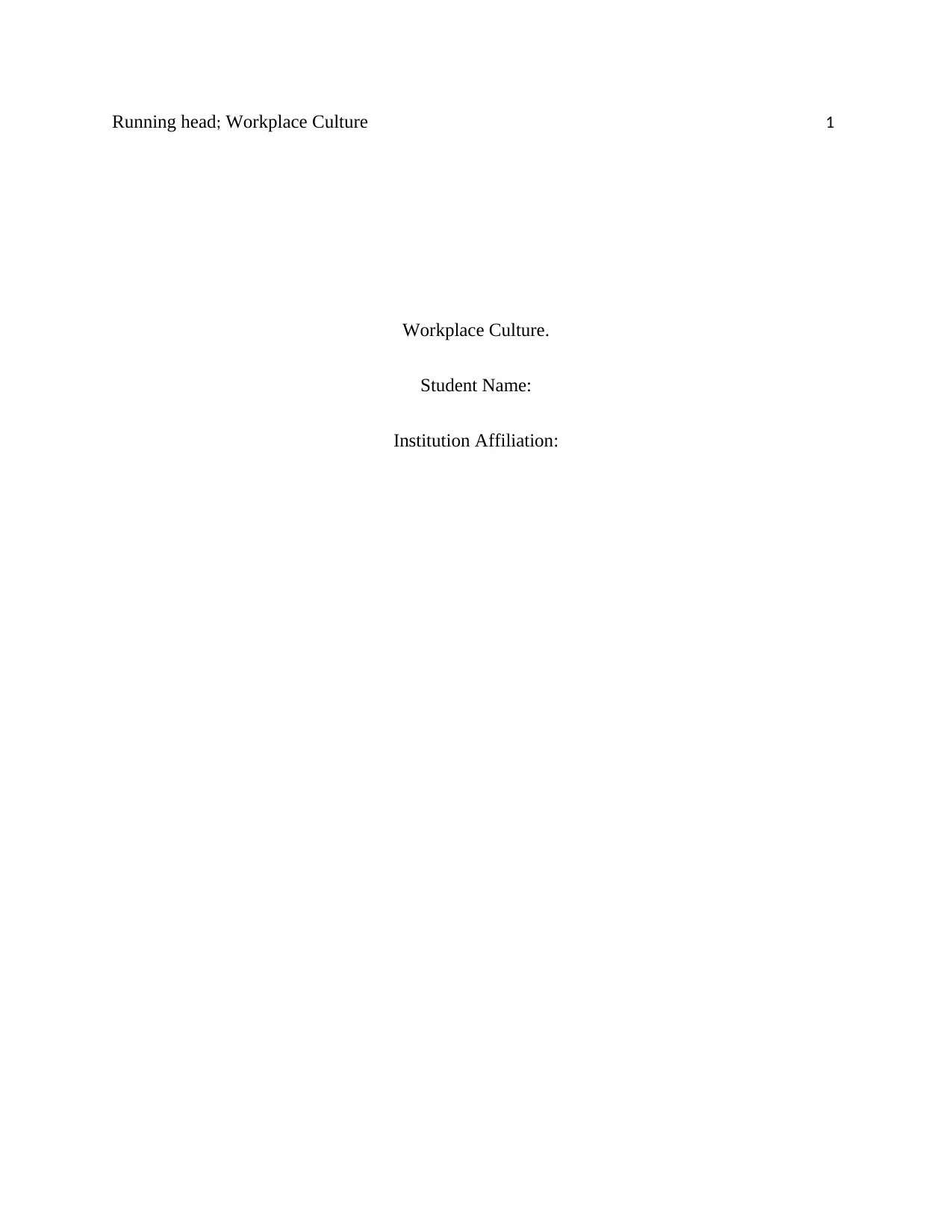
Running head; Workplace Culture 1
Workplace Culture.
Student Name:
Institution Affiliation:
Workplace Culture.
Student Name:
Institution Affiliation:
Paraphrase This Document
Need a fresh take? Get an instant paraphrase of this document with our AI Paraphraser
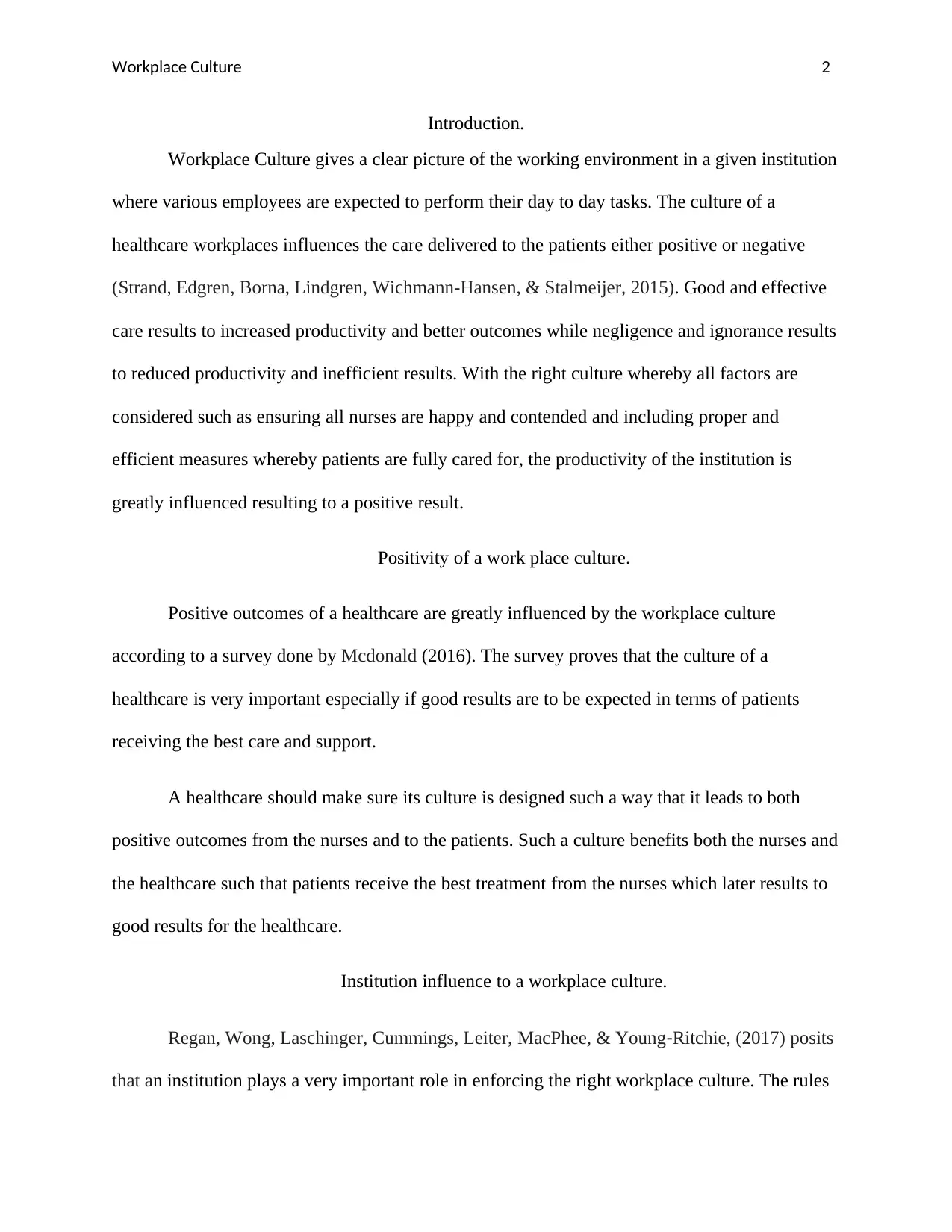
Workplace Culture 2
Introduction.
Workplace Culture gives a clear picture of the working environment in a given institution
where various employees are expected to perform their day to day tasks. The culture of a
healthcare workplaces influences the care delivered to the patients either positive or negative
(Strand, Edgren, Borna, Lindgren, Wichmann-Hansen, & Stalmeijer, 2015). Good and effective
care results to increased productivity and better outcomes while negligence and ignorance results
to reduced productivity and inefficient results. With the right culture whereby all factors are
considered such as ensuring all nurses are happy and contended and including proper and
efficient measures whereby patients are fully cared for, the productivity of the institution is
greatly influenced resulting to a positive result.
Positivity of a work place culture.
Positive outcomes of a healthcare are greatly influenced by the workplace culture
according to a survey done by Mcdonald (2016). The survey proves that the culture of a
healthcare is very important especially if good results are to be expected in terms of patients
receiving the best care and support.
A healthcare should make sure its culture is designed such a way that it leads to both
positive outcomes from the nurses and to the patients. Such a culture benefits both the nurses and
the healthcare such that patients receive the best treatment from the nurses which later results to
good results for the healthcare.
Institution influence to a workplace culture.
Regan, Wong, Laschinger, Cummings, Leiter, MacPhee, & Young‐Ritchie, (2017) posits
that an institution plays a very important role in enforcing the right workplace culture. The rules
Introduction.
Workplace Culture gives a clear picture of the working environment in a given institution
where various employees are expected to perform their day to day tasks. The culture of a
healthcare workplaces influences the care delivered to the patients either positive or negative
(Strand, Edgren, Borna, Lindgren, Wichmann-Hansen, & Stalmeijer, 2015). Good and effective
care results to increased productivity and better outcomes while negligence and ignorance results
to reduced productivity and inefficient results. With the right culture whereby all factors are
considered such as ensuring all nurses are happy and contended and including proper and
efficient measures whereby patients are fully cared for, the productivity of the institution is
greatly influenced resulting to a positive result.
Positivity of a work place culture.
Positive outcomes of a healthcare are greatly influenced by the workplace culture
according to a survey done by Mcdonald (2016). The survey proves that the culture of a
healthcare is very important especially if good results are to be expected in terms of patients
receiving the best care and support.
A healthcare should make sure its culture is designed such a way that it leads to both
positive outcomes from the nurses and to the patients. Such a culture benefits both the nurses and
the healthcare such that patients receive the best treatment from the nurses which later results to
good results for the healthcare.
Institution influence to a workplace culture.
Regan, Wong, Laschinger, Cummings, Leiter, MacPhee, & Young‐Ritchie, (2017) posits
that an institution plays a very important role in enforcing the right workplace culture. The rules
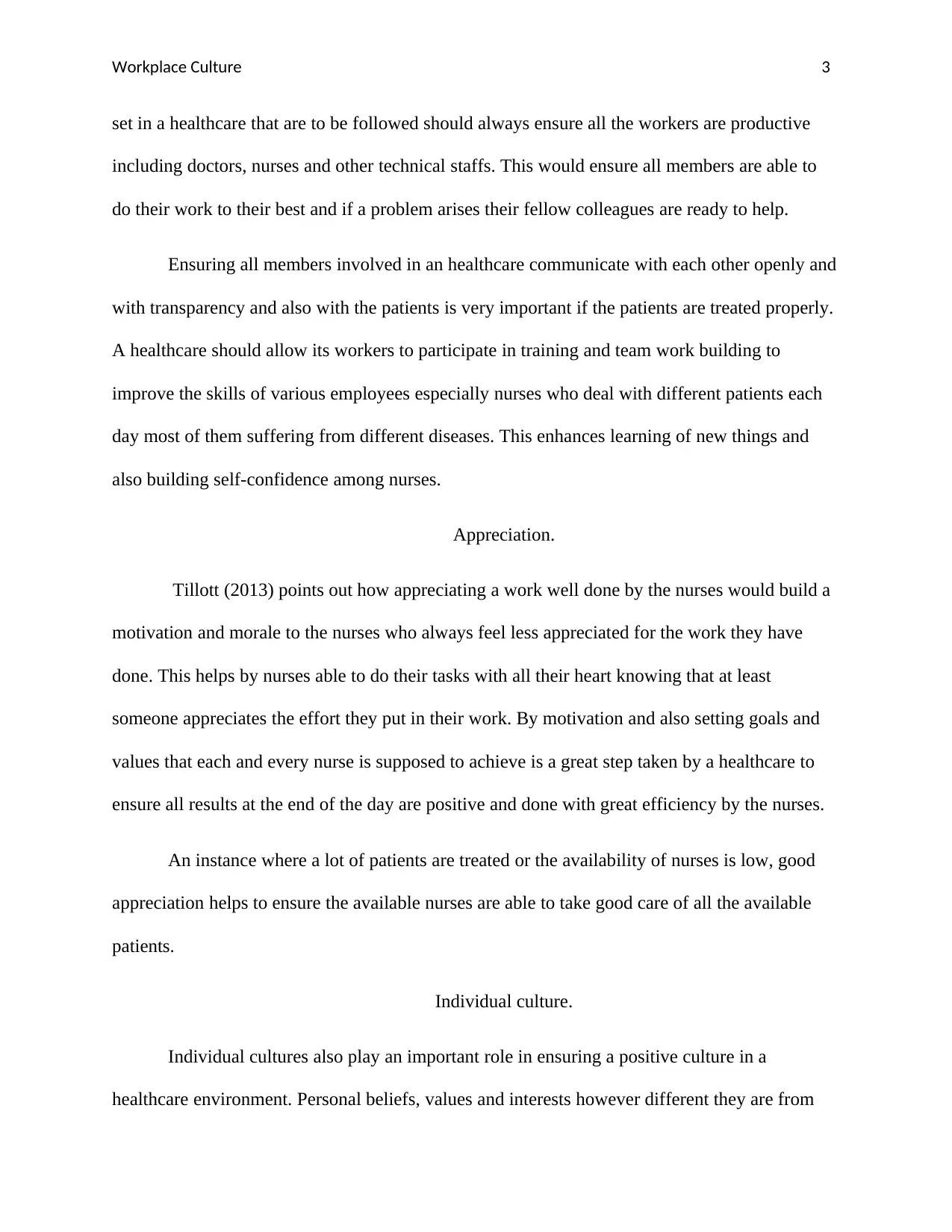
Workplace Culture 3
set in a healthcare that are to be followed should always ensure all the workers are productive
including doctors, nurses and other technical staffs. This would ensure all members are able to
do their work to their best and if a problem arises their fellow colleagues are ready to help.
Ensuring all members involved in an healthcare communicate with each other openly and
with transparency and also with the patients is very important if the patients are treated properly.
A healthcare should allow its workers to participate in training and team work building to
improve the skills of various employees especially nurses who deal with different patients each
day most of them suffering from different diseases. This enhances learning of new things and
also building self-confidence among nurses.
Appreciation.
Tillott (2013) points out how appreciating a work well done by the nurses would build a
motivation and morale to the nurses who always feel less appreciated for the work they have
done. This helps by nurses able to do their tasks with all their heart knowing that at least
someone appreciates the effort they put in their work. By motivation and also setting goals and
values that each and every nurse is supposed to achieve is a great step taken by a healthcare to
ensure all results at the end of the day are positive and done with great efficiency by the nurses.
An instance where a lot of patients are treated or the availability of nurses is low, good
appreciation helps to ensure the available nurses are able to take good care of all the available
patients.
Individual culture.
Individual cultures also play an important role in ensuring a positive culture in a
healthcare environment. Personal beliefs, values and interests however different they are from
set in a healthcare that are to be followed should always ensure all the workers are productive
including doctors, nurses and other technical staffs. This would ensure all members are able to
do their work to their best and if a problem arises their fellow colleagues are ready to help.
Ensuring all members involved in an healthcare communicate with each other openly and
with transparency and also with the patients is very important if the patients are treated properly.
A healthcare should allow its workers to participate in training and team work building to
improve the skills of various employees especially nurses who deal with different patients each
day most of them suffering from different diseases. This enhances learning of new things and
also building self-confidence among nurses.
Appreciation.
Tillott (2013) points out how appreciating a work well done by the nurses would build a
motivation and morale to the nurses who always feel less appreciated for the work they have
done. This helps by nurses able to do their tasks with all their heart knowing that at least
someone appreciates the effort they put in their work. By motivation and also setting goals and
values that each and every nurse is supposed to achieve is a great step taken by a healthcare to
ensure all results at the end of the day are positive and done with great efficiency by the nurses.
An instance where a lot of patients are treated or the availability of nurses is low, good
appreciation helps to ensure the available nurses are able to take good care of all the available
patients.
Individual culture.
Individual cultures also play an important role in ensuring a positive culture in a
healthcare environment. Personal beliefs, values and interests however different they are from
⊘ This is a preview!⊘
Do you want full access?
Subscribe today to unlock all pages.

Trusted by 1+ million students worldwide
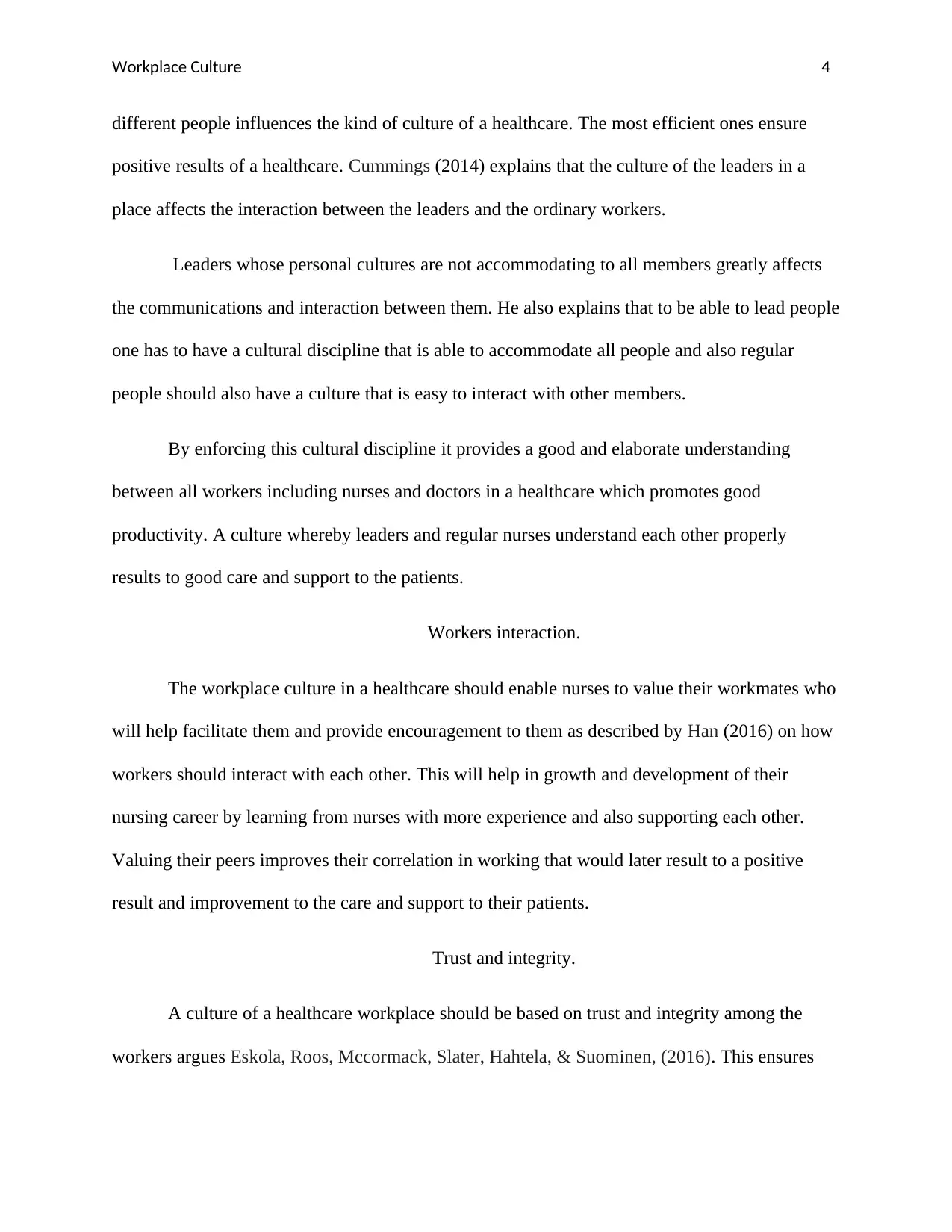
Workplace Culture 4
different people influences the kind of culture of a healthcare. The most efficient ones ensure
positive results of a healthcare. Cummings (2014) explains that the culture of the leaders in a
place affects the interaction between the leaders and the ordinary workers.
Leaders whose personal cultures are not accommodating to all members greatly affects
the communications and interaction between them. He also explains that to be able to lead people
one has to have a cultural discipline that is able to accommodate all people and also regular
people should also have a culture that is easy to interact with other members.
By enforcing this cultural discipline it provides a good and elaborate understanding
between all workers including nurses and doctors in a healthcare which promotes good
productivity. A culture whereby leaders and regular nurses understand each other properly
results to good care and support to the patients.
Workers interaction.
The workplace culture in a healthcare should enable nurses to value their workmates who
will help facilitate them and provide encouragement to them as described by Han (2016) on how
workers should interact with each other. This will help in growth and development of their
nursing career by learning from nurses with more experience and also supporting each other.
Valuing their peers improves their correlation in working that would later result to a positive
result and improvement to the care and support to their patients.
Trust and integrity.
A culture of a healthcare workplace should be based on trust and integrity among the
workers argues Eskola, Roos, Mccormack, Slater, Hahtela, & Suominen, (2016). This ensures
different people influences the kind of culture of a healthcare. The most efficient ones ensure
positive results of a healthcare. Cummings (2014) explains that the culture of the leaders in a
place affects the interaction between the leaders and the ordinary workers.
Leaders whose personal cultures are not accommodating to all members greatly affects
the communications and interaction between them. He also explains that to be able to lead people
one has to have a cultural discipline that is able to accommodate all people and also regular
people should also have a culture that is easy to interact with other members.
By enforcing this cultural discipline it provides a good and elaborate understanding
between all workers including nurses and doctors in a healthcare which promotes good
productivity. A culture whereby leaders and regular nurses understand each other properly
results to good care and support to the patients.
Workers interaction.
The workplace culture in a healthcare should enable nurses to value their workmates who
will help facilitate them and provide encouragement to them as described by Han (2016) on how
workers should interact with each other. This will help in growth and development of their
nursing career by learning from nurses with more experience and also supporting each other.
Valuing their peers improves their correlation in working that would later result to a positive
result and improvement to the care and support to their patients.
Trust and integrity.
A culture of a healthcare workplace should be based on trust and integrity among the
workers argues Eskola, Roos, Mccormack, Slater, Hahtela, & Suominen, (2016). This ensures
Paraphrase This Document
Need a fresh take? Get an instant paraphrase of this document with our AI Paraphraser
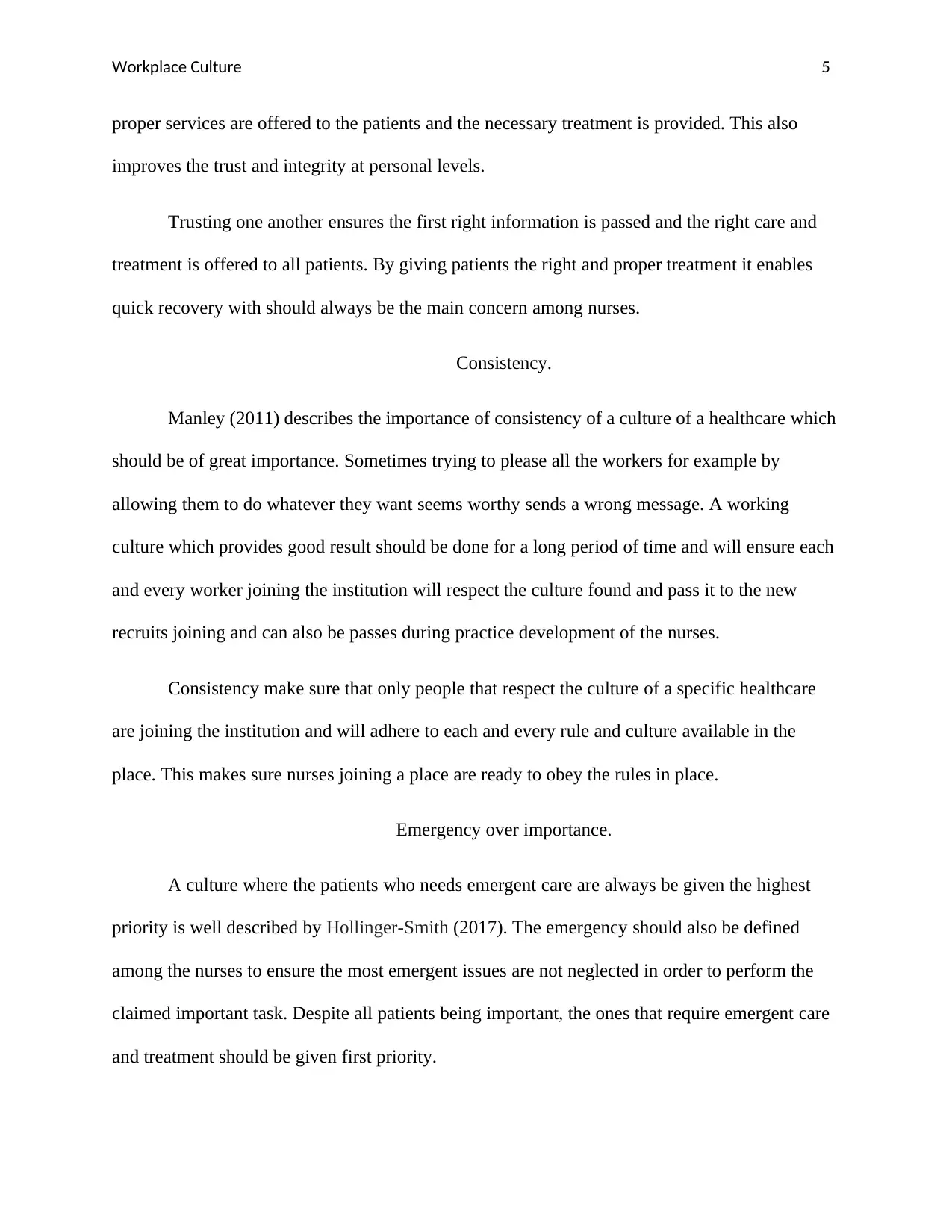
Workplace Culture 5
proper services are offered to the patients and the necessary treatment is provided. This also
improves the trust and integrity at personal levels.
Trusting one another ensures the first right information is passed and the right care and
treatment is offered to all patients. By giving patients the right and proper treatment it enables
quick recovery with should always be the main concern among nurses.
Consistency.
Manley (2011) describes the importance of consistency of a culture of a healthcare which
should be of great importance. Sometimes trying to please all the workers for example by
allowing them to do whatever they want seems worthy sends a wrong message. A working
culture which provides good result should be done for a long period of time and will ensure each
and every worker joining the institution will respect the culture found and pass it to the new
recruits joining and can also be passes during practice development of the nurses.
Consistency make sure that only people that respect the culture of a specific healthcare
are joining the institution and will adhere to each and every rule and culture available in the
place. This makes sure nurses joining a place are ready to obey the rules in place.
Emergency over importance.
A culture where the patients who needs emergent care are always be given the highest
priority is well described by Hollinger-Smith (2017). The emergency should also be defined
among the nurses to ensure the most emergent issues are not neglected in order to perform the
claimed important task. Despite all patients being important, the ones that require emergent care
and treatment should be given first priority.
proper services are offered to the patients and the necessary treatment is provided. This also
improves the trust and integrity at personal levels.
Trusting one another ensures the first right information is passed and the right care and
treatment is offered to all patients. By giving patients the right and proper treatment it enables
quick recovery with should always be the main concern among nurses.
Consistency.
Manley (2011) describes the importance of consistency of a culture of a healthcare which
should be of great importance. Sometimes trying to please all the workers for example by
allowing them to do whatever they want seems worthy sends a wrong message. A working
culture which provides good result should be done for a long period of time and will ensure each
and every worker joining the institution will respect the culture found and pass it to the new
recruits joining and can also be passes during practice development of the nurses.
Consistency make sure that only people that respect the culture of a specific healthcare
are joining the institution and will adhere to each and every rule and culture available in the
place. This makes sure nurses joining a place are ready to obey the rules in place.
Emergency over importance.
A culture where the patients who needs emergent care are always be given the highest
priority is well described by Hollinger-Smith (2017). The emergency should also be defined
among the nurses to ensure the most emergent issues are not neglected in order to perform the
claimed important task. Despite all patients being important, the ones that require emergent care
and treatment should be given first priority.
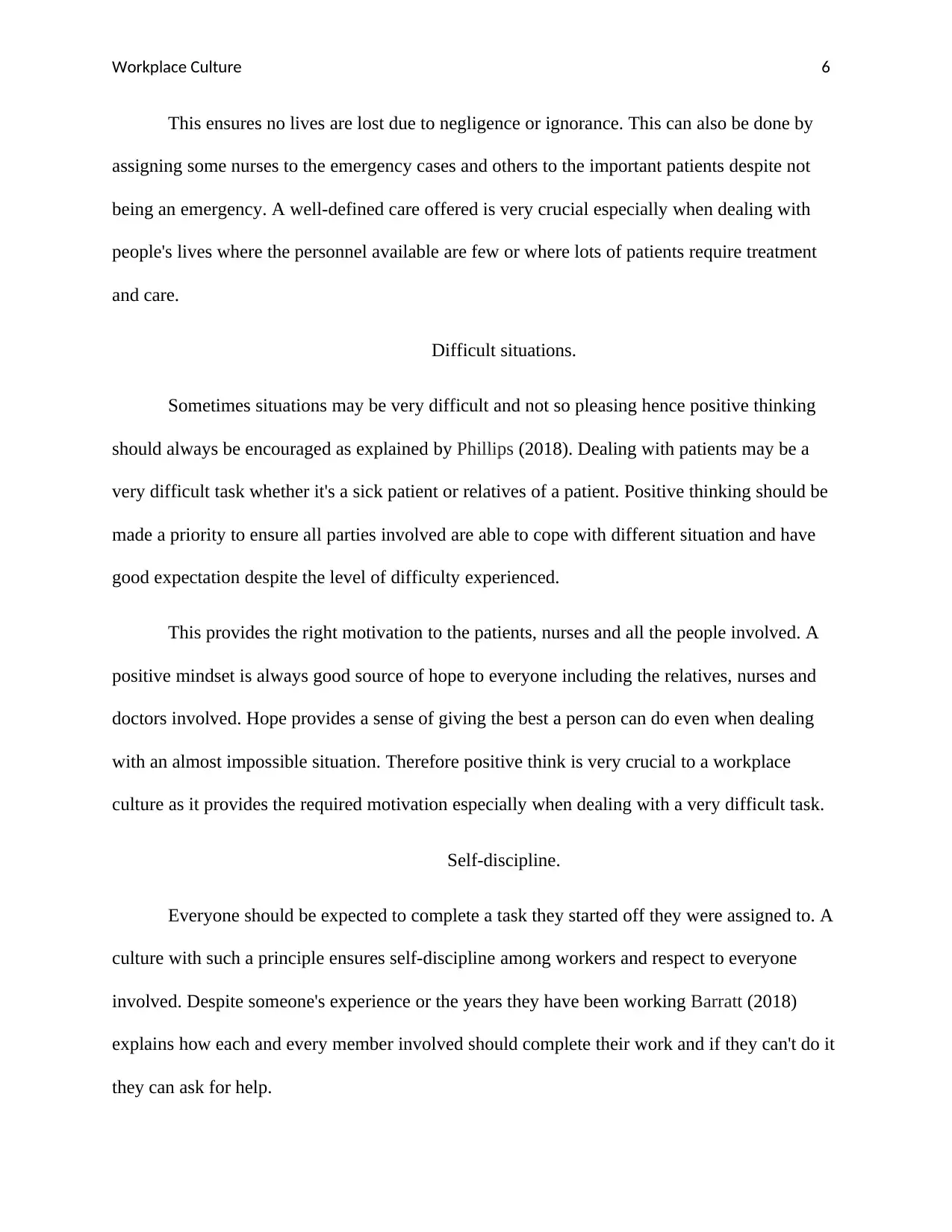
Workplace Culture 6
This ensures no lives are lost due to negligence or ignorance. This can also be done by
assigning some nurses to the emergency cases and others to the important patients despite not
being an emergency. A well-defined care offered is very crucial especially when dealing with
people's lives where the personnel available are few or where lots of patients require treatment
and care.
Difficult situations.
Sometimes situations may be very difficult and not so pleasing hence positive thinking
should always be encouraged as explained by Phillips (2018). Dealing with patients may be a
very difficult task whether it's a sick patient or relatives of a patient. Positive thinking should be
made a priority to ensure all parties involved are able to cope with different situation and have
good expectation despite the level of difficulty experienced.
This provides the right motivation to the patients, nurses and all the people involved. A
positive mindset is always good source of hope to everyone including the relatives, nurses and
doctors involved. Hope provides a sense of giving the best a person can do even when dealing
with an almost impossible situation. Therefore positive think is very crucial to a workplace
culture as it provides the required motivation especially when dealing with a very difficult task.
Self-discipline.
Everyone should be expected to complete a task they started off they were assigned to. A
culture with such a principle ensures self-discipline among workers and respect to everyone
involved. Despite someone's experience or the years they have been working Barratt (2018)
explains how each and every member involved should complete their work and if they can't do it
they can ask for help.
This ensures no lives are lost due to negligence or ignorance. This can also be done by
assigning some nurses to the emergency cases and others to the important patients despite not
being an emergency. A well-defined care offered is very crucial especially when dealing with
people's lives where the personnel available are few or where lots of patients require treatment
and care.
Difficult situations.
Sometimes situations may be very difficult and not so pleasing hence positive thinking
should always be encouraged as explained by Phillips (2018). Dealing with patients may be a
very difficult task whether it's a sick patient or relatives of a patient. Positive thinking should be
made a priority to ensure all parties involved are able to cope with different situation and have
good expectation despite the level of difficulty experienced.
This provides the right motivation to the patients, nurses and all the people involved. A
positive mindset is always good source of hope to everyone including the relatives, nurses and
doctors involved. Hope provides a sense of giving the best a person can do even when dealing
with an almost impossible situation. Therefore positive think is very crucial to a workplace
culture as it provides the required motivation especially when dealing with a very difficult task.
Self-discipline.
Everyone should be expected to complete a task they started off they were assigned to. A
culture with such a principle ensures self-discipline among workers and respect to everyone
involved. Despite someone's experience or the years they have been working Barratt (2018)
explains how each and every member involved should complete their work and if they can't do it
they can ask for help.
⊘ This is a preview!⊘
Do you want full access?
Subscribe today to unlock all pages.

Trusted by 1+ million students worldwide
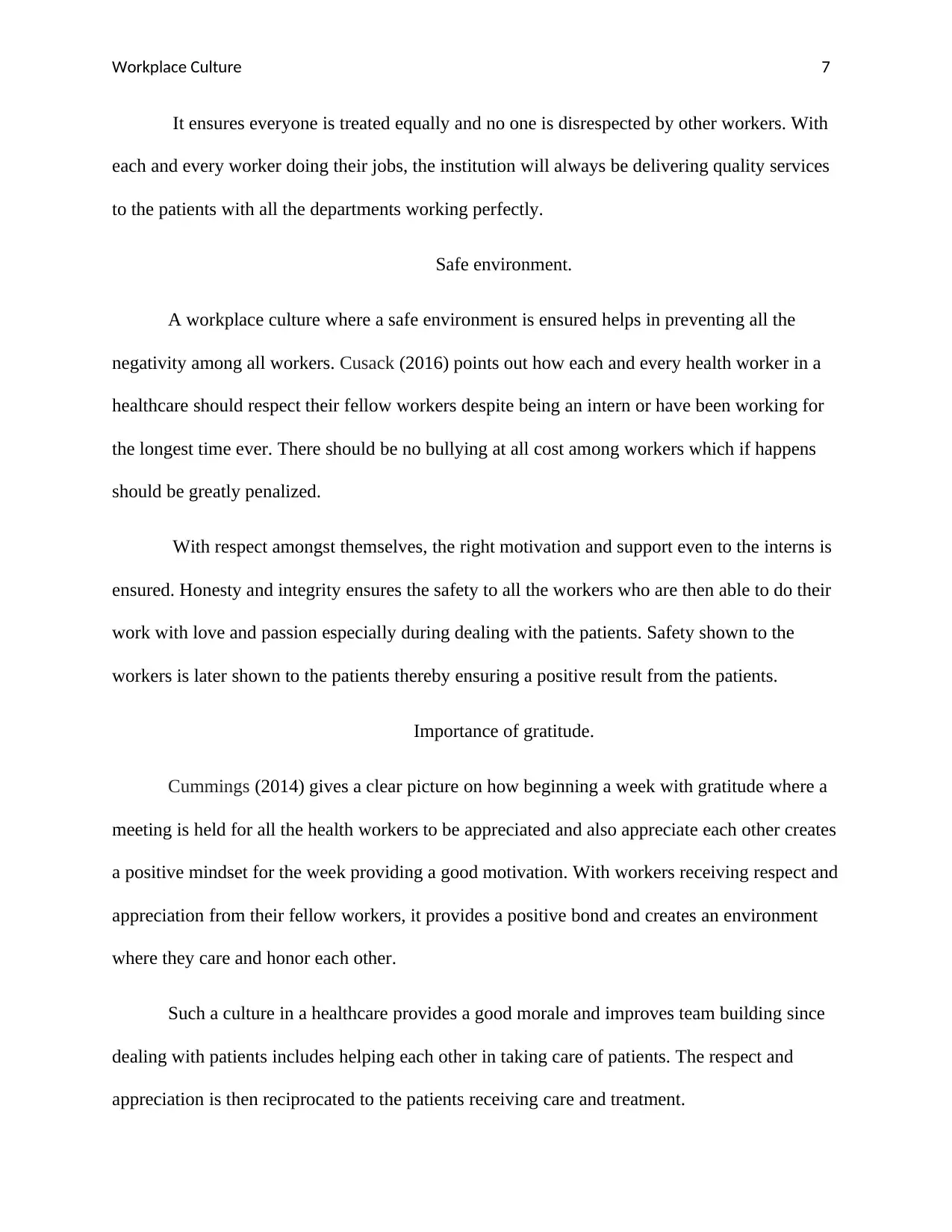
Workplace Culture 7
It ensures everyone is treated equally and no one is disrespected by other workers. With
each and every worker doing their jobs, the institution will always be delivering quality services
to the patients with all the departments working perfectly.
Safe environment.
A workplace culture where a safe environment is ensured helps in preventing all the
negativity among all workers. Cusack (2016) points out how each and every health worker in a
healthcare should respect their fellow workers despite being an intern or have been working for
the longest time ever. There should be no bullying at all cost among workers which if happens
should be greatly penalized.
With respect amongst themselves, the right motivation and support even to the interns is
ensured. Honesty and integrity ensures the safety to all the workers who are then able to do their
work with love and passion especially during dealing with the patients. Safety shown to the
workers is later shown to the patients thereby ensuring a positive result from the patients.
Importance of gratitude.
Cummings (2014) gives a clear picture on how beginning a week with gratitude where a
meeting is held for all the health workers to be appreciated and also appreciate each other creates
a positive mindset for the week providing a good motivation. With workers receiving respect and
appreciation from their fellow workers, it provides a positive bond and creates an environment
where they care and honor each other.
Such a culture in a healthcare provides a good morale and improves team building since
dealing with patients includes helping each other in taking care of patients. The respect and
appreciation is then reciprocated to the patients receiving care and treatment.
It ensures everyone is treated equally and no one is disrespected by other workers. With
each and every worker doing their jobs, the institution will always be delivering quality services
to the patients with all the departments working perfectly.
Safe environment.
A workplace culture where a safe environment is ensured helps in preventing all the
negativity among all workers. Cusack (2016) points out how each and every health worker in a
healthcare should respect their fellow workers despite being an intern or have been working for
the longest time ever. There should be no bullying at all cost among workers which if happens
should be greatly penalized.
With respect amongst themselves, the right motivation and support even to the interns is
ensured. Honesty and integrity ensures the safety to all the workers who are then able to do their
work with love and passion especially during dealing with the patients. Safety shown to the
workers is later shown to the patients thereby ensuring a positive result from the patients.
Importance of gratitude.
Cummings (2014) gives a clear picture on how beginning a week with gratitude where a
meeting is held for all the health workers to be appreciated and also appreciate each other creates
a positive mindset for the week providing a good motivation. With workers receiving respect and
appreciation from their fellow workers, it provides a positive bond and creates an environment
where they care and honor each other.
Such a culture in a healthcare provides a good morale and improves team building since
dealing with patients includes helping each other in taking care of patients. The respect and
appreciation is then reciprocated to the patients receiving care and treatment.
Paraphrase This Document
Need a fresh take? Get an instant paraphrase of this document with our AI Paraphraser
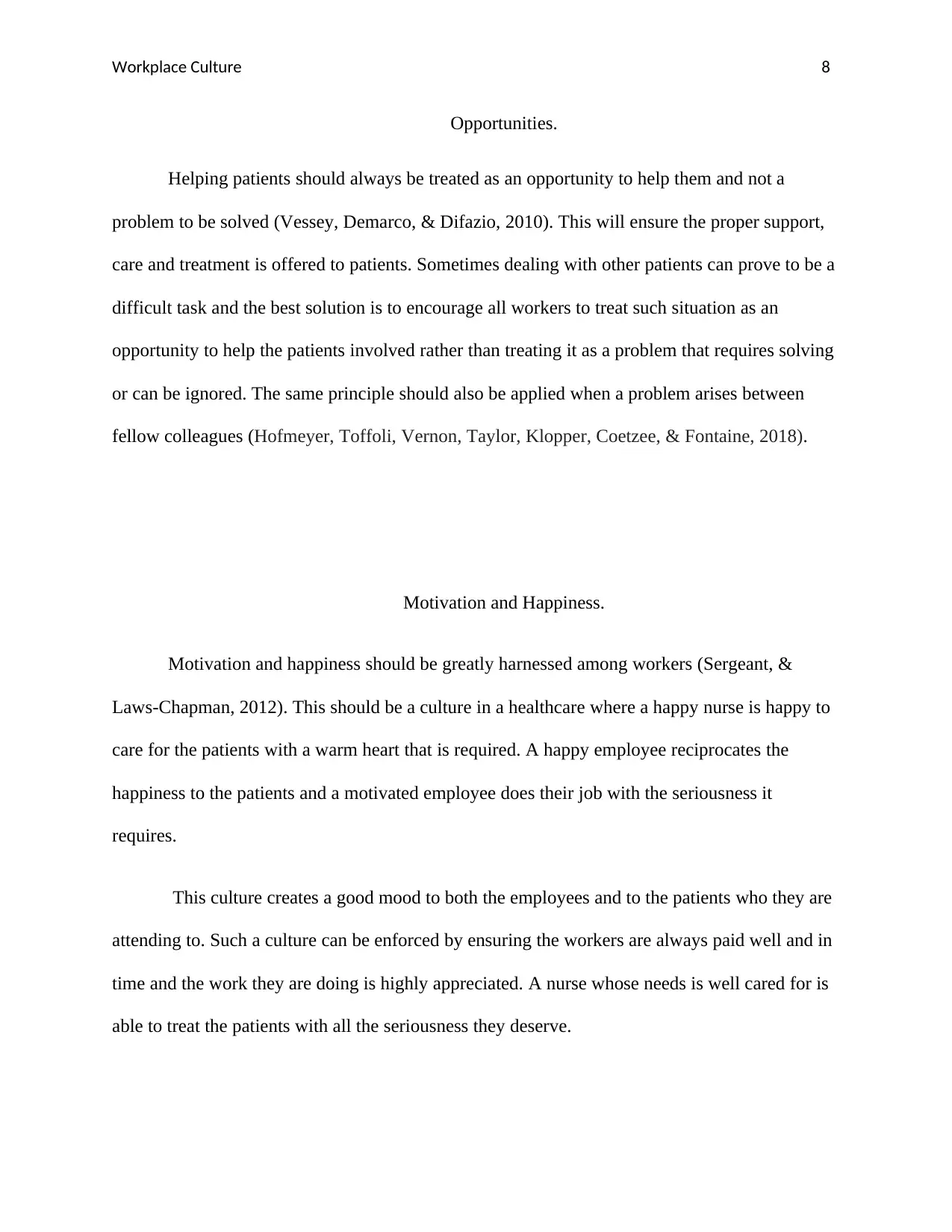
Workplace Culture 8
Opportunities.
Helping patients should always be treated as an opportunity to help them and not a
problem to be solved (Vessey, Demarco, & Difazio, 2010). This will ensure the proper support,
care and treatment is offered to patients. Sometimes dealing with other patients can prove to be a
difficult task and the best solution is to encourage all workers to treat such situation as an
opportunity to help the patients involved rather than treating it as a problem that requires solving
or can be ignored. The same principle should also be applied when a problem arises between
fellow colleagues (Hofmeyer, Toffoli, Vernon, Taylor, Klopper, Coetzee, & Fontaine, 2018).
Motivation and Happiness.
Motivation and happiness should be greatly harnessed among workers (Sergeant, &
Laws-Chapman, 2012). This should be a culture in a healthcare where a happy nurse is happy to
care for the patients with a warm heart that is required. A happy employee reciprocates the
happiness to the patients and a motivated employee does their job with the seriousness it
requires.
This culture creates a good mood to both the employees and to the patients who they are
attending to. Such a culture can be enforced by ensuring the workers are always paid well and in
time and the work they are doing is highly appreciated. A nurse whose needs is well cared for is
able to treat the patients with all the seriousness they deserve.
Opportunities.
Helping patients should always be treated as an opportunity to help them and not a
problem to be solved (Vessey, Demarco, & Difazio, 2010). This will ensure the proper support,
care and treatment is offered to patients. Sometimes dealing with other patients can prove to be a
difficult task and the best solution is to encourage all workers to treat such situation as an
opportunity to help the patients involved rather than treating it as a problem that requires solving
or can be ignored. The same principle should also be applied when a problem arises between
fellow colleagues (Hofmeyer, Toffoli, Vernon, Taylor, Klopper, Coetzee, & Fontaine, 2018).
Motivation and Happiness.
Motivation and happiness should be greatly harnessed among workers (Sergeant, &
Laws-Chapman, 2012). This should be a culture in a healthcare where a happy nurse is happy to
care for the patients with a warm heart that is required. A happy employee reciprocates the
happiness to the patients and a motivated employee does their job with the seriousness it
requires.
This culture creates a good mood to both the employees and to the patients who they are
attending to. Such a culture can be enforced by ensuring the workers are always paid well and in
time and the work they are doing is highly appreciated. A nurse whose needs is well cared for is
able to treat the patients with all the seriousness they deserve.
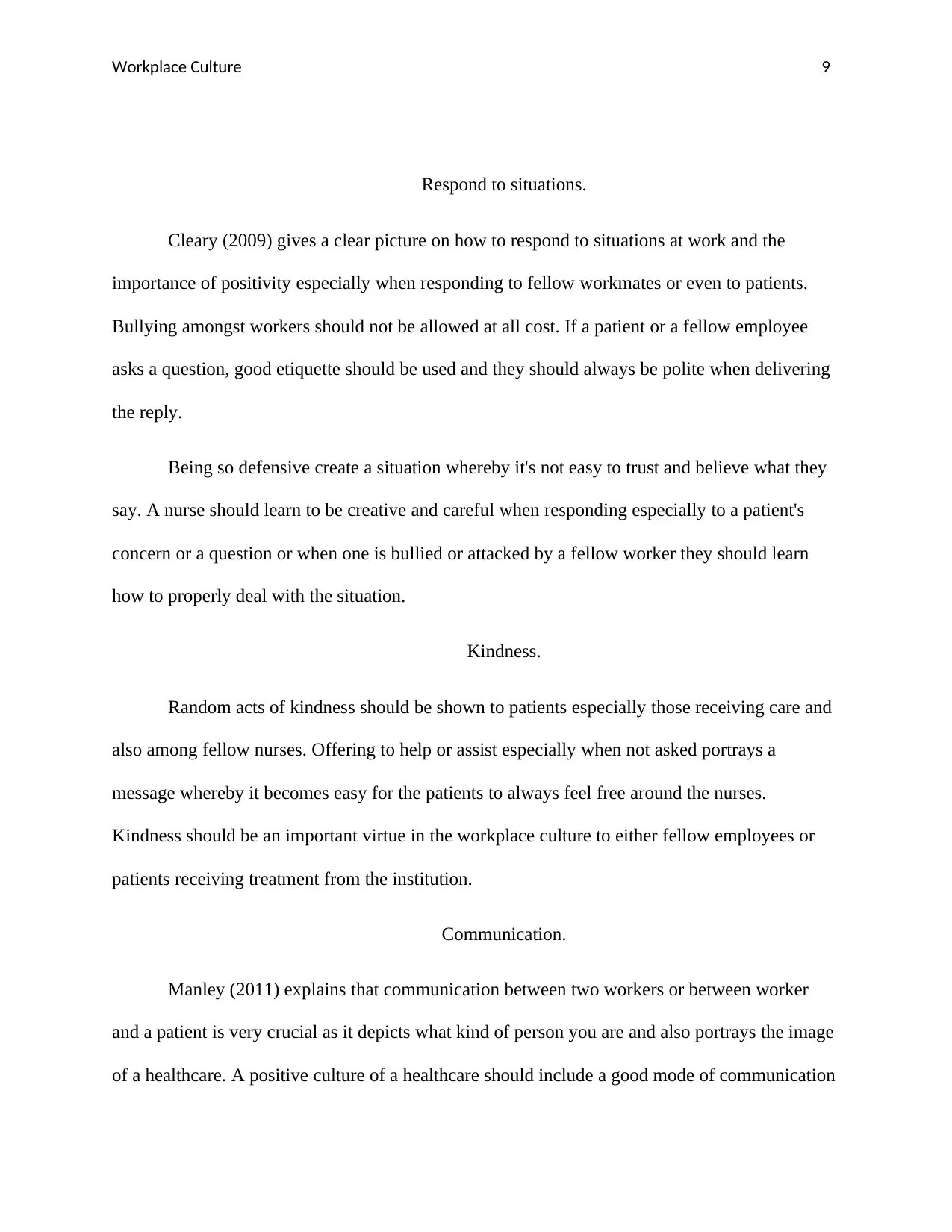
Workplace Culture 9
Respond to situations.
Cleary (2009) gives a clear picture on how to respond to situations at work and the
importance of positivity especially when responding to fellow workmates or even to patients.
Bullying amongst workers should not be allowed at all cost. If a patient or a fellow employee
asks a question, good etiquette should be used and they should always be polite when delivering
the reply.
Being so defensive create a situation whereby it's not easy to trust and believe what they
say. A nurse should learn to be creative and careful when responding especially to a patient's
concern or a question or when one is bullied or attacked by a fellow worker they should learn
how to properly deal with the situation.
Kindness.
Random acts of kindness should be shown to patients especially those receiving care and
also among fellow nurses. Offering to help or assist especially when not asked portrays a
message whereby it becomes easy for the patients to always feel free around the nurses.
Kindness should be an important virtue in the workplace culture to either fellow employees or
patients receiving treatment from the institution.
Communication.
Manley (2011) explains that communication between two workers or between worker
and a patient is very crucial as it depicts what kind of person you are and also portrays the image
of a healthcare. A positive culture of a healthcare should include a good mode of communication
Respond to situations.
Cleary (2009) gives a clear picture on how to respond to situations at work and the
importance of positivity especially when responding to fellow workmates or even to patients.
Bullying amongst workers should not be allowed at all cost. If a patient or a fellow employee
asks a question, good etiquette should be used and they should always be polite when delivering
the reply.
Being so defensive create a situation whereby it's not easy to trust and believe what they
say. A nurse should learn to be creative and careful when responding especially to a patient's
concern or a question or when one is bullied or attacked by a fellow worker they should learn
how to properly deal with the situation.
Kindness.
Random acts of kindness should be shown to patients especially those receiving care and
also among fellow nurses. Offering to help or assist especially when not asked portrays a
message whereby it becomes easy for the patients to always feel free around the nurses.
Kindness should be an important virtue in the workplace culture to either fellow employees or
patients receiving treatment from the institution.
Communication.
Manley (2011) explains that communication between two workers or between worker
and a patient is very crucial as it depicts what kind of person you are and also portrays the image
of a healthcare. A positive culture of a healthcare should include a good mode of communication
⊘ This is a preview!⊘
Do you want full access?
Subscribe today to unlock all pages.

Trusted by 1+ million students worldwide
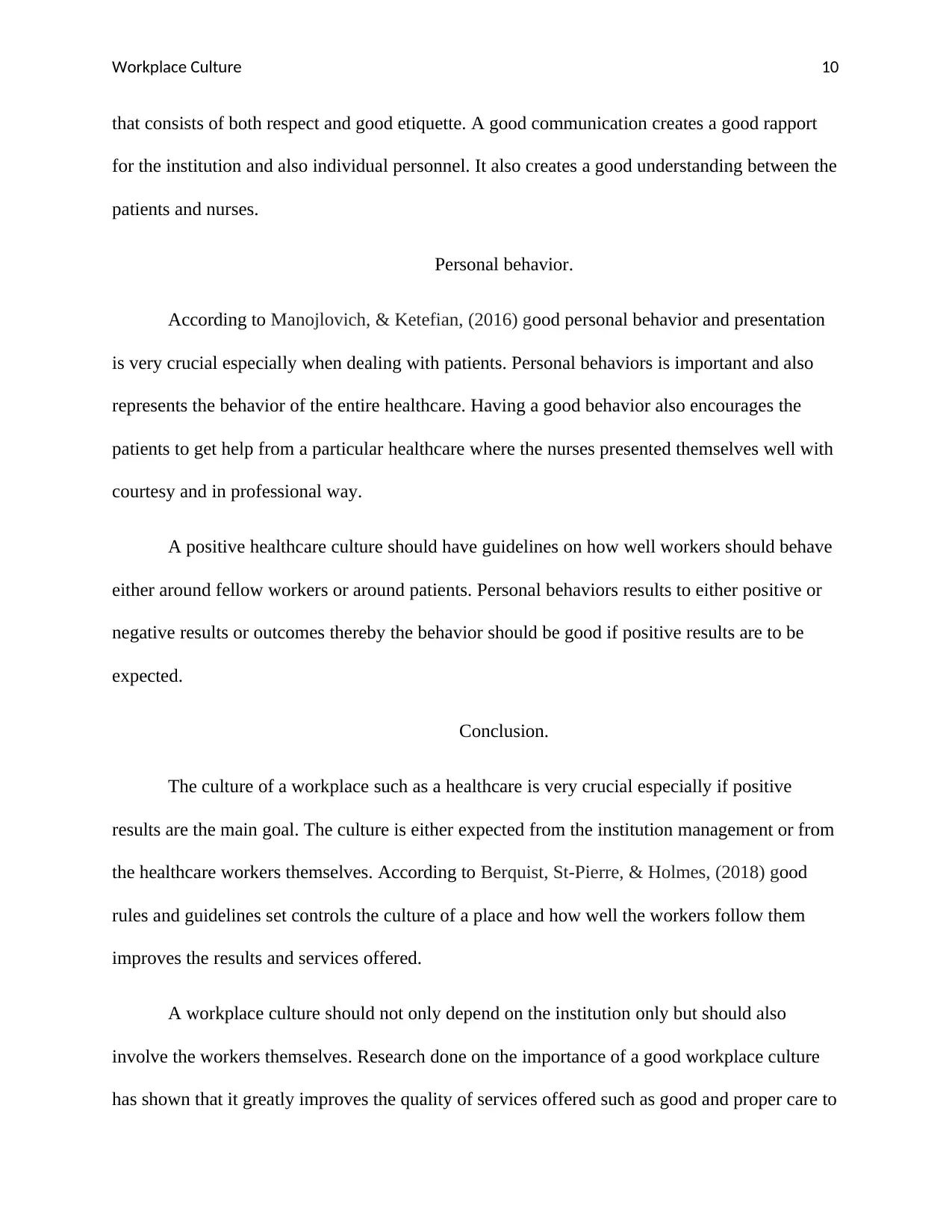
Workplace Culture 10
that consists of both respect and good etiquette. A good communication creates a good rapport
for the institution and also individual personnel. It also creates a good understanding between the
patients and nurses.
Personal behavior.
According to Manojlovich, & Ketefian, (2016) good personal behavior and presentation
is very crucial especially when dealing with patients. Personal behaviors is important and also
represents the behavior of the entire healthcare. Having a good behavior also encourages the
patients to get help from a particular healthcare where the nurses presented themselves well with
courtesy and in professional way.
A positive healthcare culture should have guidelines on how well workers should behave
either around fellow workers or around patients. Personal behaviors results to either positive or
negative results or outcomes thereby the behavior should be good if positive results are to be
expected.
Conclusion.
The culture of a workplace such as a healthcare is very crucial especially if positive
results are the main goal. The culture is either expected from the institution management or from
the healthcare workers themselves. According to Berquist, St-Pierre, & Holmes, (2018) good
rules and guidelines set controls the culture of a place and how well the workers follow them
improves the results and services offered.
A workplace culture should not only depend on the institution only but should also
involve the workers themselves. Research done on the importance of a good workplace culture
has shown that it greatly improves the quality of services offered such as good and proper care to
that consists of both respect and good etiquette. A good communication creates a good rapport
for the institution and also individual personnel. It also creates a good understanding between the
patients and nurses.
Personal behavior.
According to Manojlovich, & Ketefian, (2016) good personal behavior and presentation
is very crucial especially when dealing with patients. Personal behaviors is important and also
represents the behavior of the entire healthcare. Having a good behavior also encourages the
patients to get help from a particular healthcare where the nurses presented themselves well with
courtesy and in professional way.
A positive healthcare culture should have guidelines on how well workers should behave
either around fellow workers or around patients. Personal behaviors results to either positive or
negative results or outcomes thereby the behavior should be good if positive results are to be
expected.
Conclusion.
The culture of a workplace such as a healthcare is very crucial especially if positive
results are the main goal. The culture is either expected from the institution management or from
the healthcare workers themselves. According to Berquist, St-Pierre, & Holmes, (2018) good
rules and guidelines set controls the culture of a place and how well the workers follow them
improves the results and services offered.
A workplace culture should not only depend on the institution only but should also
involve the workers themselves. Research done on the importance of a good workplace culture
has shown that it greatly improves the quality of services offered such as good and proper care to
Paraphrase This Document
Need a fresh take? Get an instant paraphrase of this document with our AI Paraphraser
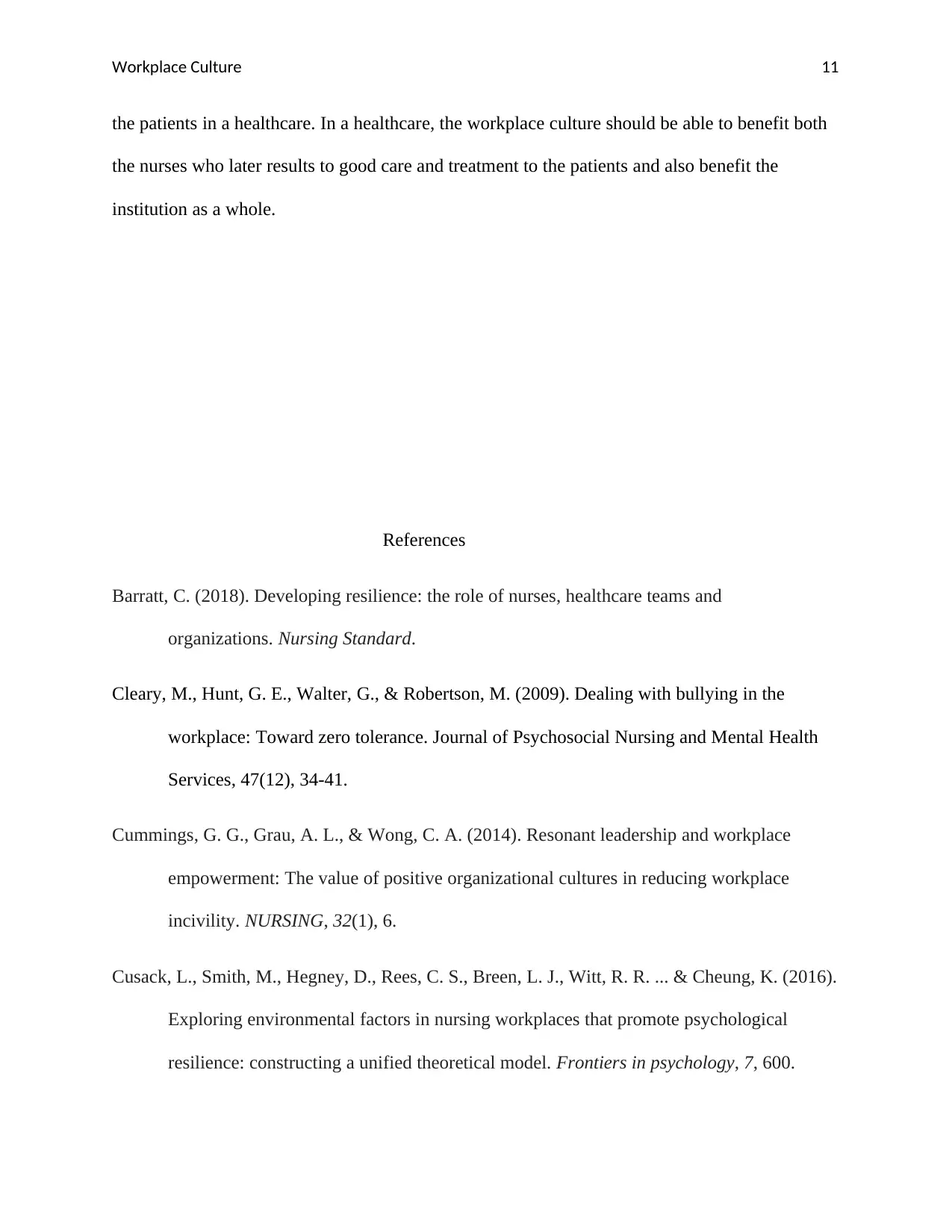
Workplace Culture 11
the patients in a healthcare. In a healthcare, the workplace culture should be able to benefit both
the nurses who later results to good care and treatment to the patients and also benefit the
institution as a whole.
References
Barratt, C. (2018). Developing resilience: the role of nurses, healthcare teams and
organizations. Nursing Standard.
Cleary, M., Hunt, G. E., Walter, G., & Robertson, M. (2009). Dealing with bullying in the
workplace: Toward zero tolerance. Journal of Psychosocial Nursing and Mental Health
Services, 47(12), 34-41.
Cummings, G. G., Grau, A. L., & Wong, C. A. (2014). Resonant leadership and workplace
empowerment: The value of positive organizational cultures in reducing workplace
incivility. NURSING, 32(1), 6.
Cusack, L., Smith, M., Hegney, D., Rees, C. S., Breen, L. J., Witt, R. R. ... & Cheung, K. (2016).
Exploring environmental factors in nursing workplaces that promote psychological
resilience: constructing a unified theoretical model. Frontiers in psychology, 7, 600.
the patients in a healthcare. In a healthcare, the workplace culture should be able to benefit both
the nurses who later results to good care and treatment to the patients and also benefit the
institution as a whole.
References
Barratt, C. (2018). Developing resilience: the role of nurses, healthcare teams and
organizations. Nursing Standard.
Cleary, M., Hunt, G. E., Walter, G., & Robertson, M. (2009). Dealing with bullying in the
workplace: Toward zero tolerance. Journal of Psychosocial Nursing and Mental Health
Services, 47(12), 34-41.
Cummings, G. G., Grau, A. L., & Wong, C. A. (2014). Resonant leadership and workplace
empowerment: The value of positive organizational cultures in reducing workplace
incivility. NURSING, 32(1), 6.
Cusack, L., Smith, M., Hegney, D., Rees, C. S., Breen, L. J., Witt, R. R. ... & Cheung, K. (2016).
Exploring environmental factors in nursing workplaces that promote psychological
resilience: constructing a unified theoretical model. Frontiers in psychology, 7, 600.
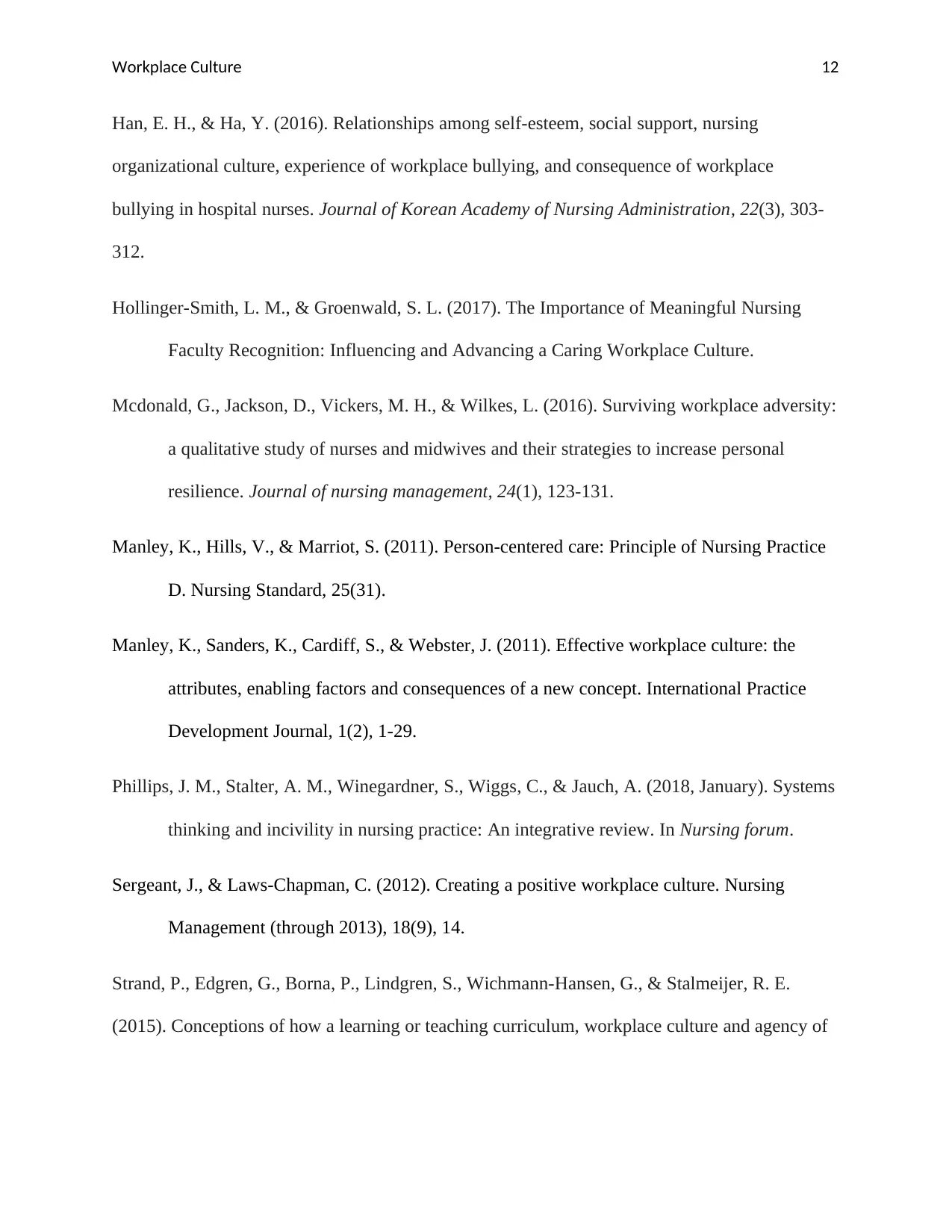
Workplace Culture 12
Han, E. H., & Ha, Y. (2016). Relationships among self-esteem, social support, nursing
organizational culture, experience of workplace bullying, and consequence of workplace
bullying in hospital nurses. Journal of Korean Academy of Nursing Administration, 22(3), 303-
312.
Hollinger-Smith, L. M., & Groenwald, S. L. (2017). The Importance of Meaningful Nursing
Faculty Recognition: Influencing and Advancing a Caring Workplace Culture.
Mcdonald, G., Jackson, D., Vickers, M. H., & Wilkes, L. (2016). Surviving workplace adversity:
a qualitative study of nurses and midwives and their strategies to increase personal
resilience. Journal of nursing management, 24(1), 123-131.
Manley, K., Hills, V., & Marriot, S. (2011). Person-centered care: Principle of Nursing Practice
D. Nursing Standard, 25(31).
Manley, K., Sanders, K., Cardiff, S., & Webster, J. (2011). Effective workplace culture: the
attributes, enabling factors and consequences of a new concept. International Practice
Development Journal, 1(2), 1-29.
Phillips, J. M., Stalter, A. M., Winegardner, S., Wiggs, C., & Jauch, A. (2018, January). Systems
thinking and incivility in nursing practice: An integrative review. In Nursing forum.
Sergeant, J., & Laws-Chapman, C. (2012). Creating a positive workplace culture. Nursing
Management (through 2013), 18(9), 14.
Strand, P., Edgren, G., Borna, P., Lindgren, S., Wichmann-Hansen, G., & Stalmeijer, R. E.
(2015). Conceptions of how a learning or teaching curriculum, workplace culture and agency of
Han, E. H., & Ha, Y. (2016). Relationships among self-esteem, social support, nursing
organizational culture, experience of workplace bullying, and consequence of workplace
bullying in hospital nurses. Journal of Korean Academy of Nursing Administration, 22(3), 303-
312.
Hollinger-Smith, L. M., & Groenwald, S. L. (2017). The Importance of Meaningful Nursing
Faculty Recognition: Influencing and Advancing a Caring Workplace Culture.
Mcdonald, G., Jackson, D., Vickers, M. H., & Wilkes, L. (2016). Surviving workplace adversity:
a qualitative study of nurses and midwives and their strategies to increase personal
resilience. Journal of nursing management, 24(1), 123-131.
Manley, K., Hills, V., & Marriot, S. (2011). Person-centered care: Principle of Nursing Practice
D. Nursing Standard, 25(31).
Manley, K., Sanders, K., Cardiff, S., & Webster, J. (2011). Effective workplace culture: the
attributes, enabling factors and consequences of a new concept. International Practice
Development Journal, 1(2), 1-29.
Phillips, J. M., Stalter, A. M., Winegardner, S., Wiggs, C., & Jauch, A. (2018, January). Systems
thinking and incivility in nursing practice: An integrative review. In Nursing forum.
Sergeant, J., & Laws-Chapman, C. (2012). Creating a positive workplace culture. Nursing
Management (through 2013), 18(9), 14.
Strand, P., Edgren, G., Borna, P., Lindgren, S., Wichmann-Hansen, G., & Stalmeijer, R. E.
(2015). Conceptions of how a learning or teaching curriculum, workplace culture and agency of
⊘ This is a preview!⊘
Do you want full access?
Subscribe today to unlock all pages.

Trusted by 1+ million students worldwide
1 out of 14
Related Documents
Your All-in-One AI-Powered Toolkit for Academic Success.
+13062052269
info@desklib.com
Available 24*7 on WhatsApp / Email
![[object Object]](/_next/static/media/star-bottom.7253800d.svg)
Unlock your academic potential
Copyright © 2020–2025 A2Z Services. All Rights Reserved. Developed and managed by ZUCOL.





